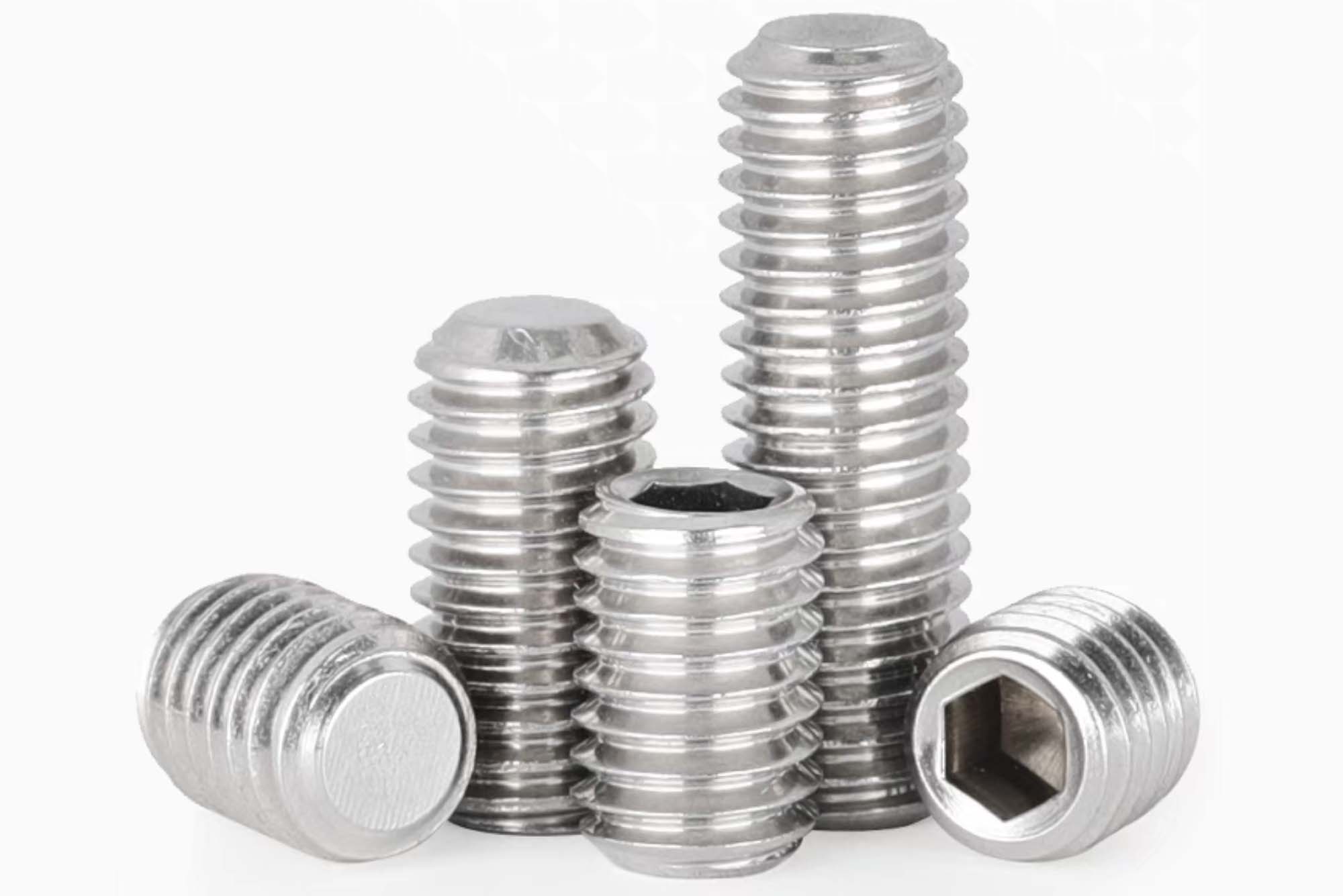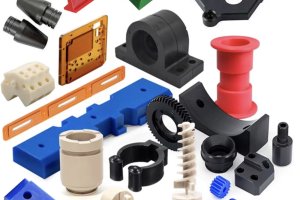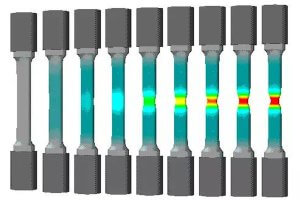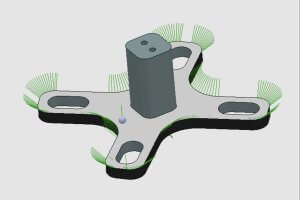Introduction
Set screw might be small components, but they’re crucial in countless mechanical assemblies. Throughout my experience in CNC machining, I’ve seen how a tiny set screw can mean the difference between equipment running smoothly or failing entirely. But despite their importance, I’ve also noticed they’re often overlooked or misunderstood.
In this guide, I’ll share everything I’ve learned about manufacturing and applying set screws effectively using CNC technology. We’ll dive into detailed machining techniques, suitable materials, best practices, and even common mistakes to avoid.
If you’re an engineer, machinist, custom parts purchasing manager or simply someone looking to better understand how set screws are made or used, this guide is for you.
Chapter 1: What is a Set Screw?
Before we discuss CNC machining, let’s clearly understand what a set screw actually is.
Definition and Purpose of Set Screws
A set screw is a threaded fastener typically without a head. Its primary job is to secure one object within or against another without needing a nut. They’re usually inserted directly into threaded holes.
Set screws are often small, but they’re indispensable for positioning, securing, or adjusting mechanical components such as pulleys, gears, collars, and handles.
Types of Set Screws
Set screws come in various types, each suited to specific applications. Here’s a quick overview:
| Type | Tip Shape | Common Uses |
|---|---|---|
| Cup Point | Concave | General-purpose, excellent grip |
| Flat Point | Flat | Less damage to surfaces, easy adjustments |
| Cone Point | Pointed, cone shape | High precision, permanent positioning |
| Dog Point | Cylindrical tip | Guiding into a hole, aligning parts |
| Knurled Point | Serrated | Secure gripping, vibration resistance |
| Oval Point | Rounded | Minimal surface damage, softer materials |
| Half Dog Point | Short cylindrical tip | Precise location, limited clearance |
In my experience, the cup-point set screw is the most commonly used due to its versatility. But if precision positioning is required, cone-point or dog-point screws are often the best choices.
Differences Between Set Screws and Other Fasteners
You might wonder how set screws differ from other fasteners like bolts or machine screws. Here’s a simplified comparison:
- Set Screws:
No head, designed to clamp or hold objects in position through friction or indentation. - Bolts and Machine Screws:
Typically have heads, require nuts or threaded holes, used mainly for joining separate parts together with high clamping force.
What I appreciate about set screws is their discreetness and ability to hold components firmly without additional hardware.
Chapter 2: How to Manufacture Set Screws Using CNC?
CNC machining is my preferred method for manufacturing high-quality set screws. It ensures precision, repeatability, and efficiency, especially for custom designs or tight-tolerance applications.
Selecting the Right CNC Equipment and Tools
Choosing the right equipment can significantly influence the quality of your set screws. CNC machines commonly used include:
- CNC Lathes: Ideal for round, threaded parts like set screws.
- Swiss-type CNC Lathes: Excellent for small-diameter precision set screws.
- CNC Mills: Used when complex head or point geometry is required.
CNC Machining Process for Set Screws
Manufacturing set screws typically involves several precise steps:
- Material Selection and Setup:
Start with bar stock in chosen materials like stainless steel, brass, or titanium. - Turning Operation:
CNC lathe machines cut the set screw diameter to precise dimensions. - Threading Operation:
Threads are created using single-point threading, thread rolling, or thread milling. - Point Machining:
Set screw tips (cup, cone, flat, etc.) are precisely machined or ground. - Parting and Finishing:
Set screws are parted off from the bar and undergo surface treatments such as passivation or zinc plating.
Here’s a table outlining typical CNC machining parameters based on my practical experience:
| Material | Cutting Speed (SFM) | Feed Rate (IPR) | Thread Method |
|---|---|---|---|
| Stainless Steel | 150-300 | 0.003-0.008 | Single-point or Thread-rolling |
| Alloy Steel | 200-400 | 0.004-0.010 | Thread-rolling recommended |
| Brass | 300-600 | 0.005-0.012 | Single-point threading |
| Titanium | 50-150 | 0.002-0.005 | Thread milling or Single-point |
| Aluminum | 500-1000 | 0.008-0.015 | Single-point threading |
I recommend adjusting these parameters based on specific equipment and tooling.
Thread Cutting Techniques
Choosing a threading technique depends on your material and desired outcomes:
- Single-Point Threading:
Highly flexible, suitable for smaller batches, precision work. - Thread Rolling:
Produces strong threads, excellent for mass production. - Thread Milling:
Great for tough materials like titanium, achieving precise threads.
Materials Used for CNC-Manufactured Set Screws
Set screws can be manufactured from various materials depending on the application. Common materials include:
- Stainless Steel (304, 316): Corrosion resistance, ideal for outdoor or marine applications.
- Alloy Steel: High strength, good wear resistance.
- Brass: Corrosion-resistant, suitable for electrical and decorative purposes.
- Titanium: Lightweight, strong, corrosion-resistant, ideal for aerospace.
- Aluminum: Lightweight, corrosion-resistant, for low-load applications.
Surface Treatments and Coatings
The right coating enhances durability and function:
- Black Oxide: Mild corrosion resistance, improved appearance.
- Passivation: Excellent corrosion resistance for stainless steel.
- Zinc Plating: General corrosion protection for steel screws.
- Anodizing: Ideal for aluminum, corrosion-resistant.
- Phosphate Coating: Enhanced friction properties, common in automotive applications.
I’ve personally found passivation essential for stainless set screws used in harsh environments.
Common Issues and Solutions in CNC Set Screw Manufacturing
From experience, here are typical CNC machining issues and solutions:
- Inaccurate Threads: Check cutting tools, recalibrate CNC machines regularly.
- Surface Imperfections: Adjust cutting parameters or use finishing tools.
- Burr Formation: Implement deburring processes or adjust cutting parameters.
Chapter 3: Applications of Set Screws Across Industries
Set screws may look simple, but they are crucial in a variety of industries. I’ve personally worked on multiple projects where choosing the right set screw made all the difference. Let’s explore where set screws typically shine:
Mechanical Manufacturing and Processing
In my experience, mechanical assemblies often rely heavily on set screws for precision positioning. Examples include:
- Fixing pulleys and gears onto shafts.
- Securing shaft collars and couplings.
- Positioning components inside machinery accurately.
Set screws offer reliable, adjustable fastening without requiring large spaces, making them perfect for tight, intricate mechanical setups.
Industrial Equipment and Automation
Automated production lines frequently use set screws. They help with:
- Precise positioning of sensors or small actuators.
- Adjustment mechanisms requiring repeated fine-tuning.
- Locking movable parts in place for reliable operation.
Personally, I’ve observed that set screws provide flexibility in adjustments without sacrificing stability in automated equipment.
Precision Instruments and Electronics
Delicate electronic assemblies and precision instruments often need miniature set screws. They’re vital in:
- Adjusting optical elements in lab equipment.
- Securing internal components in precision electronics.
- Fine-tuning mechanical stops and limiters in measurement tools.
I’ve machined numerous miniature set screws used in high-precision medical instruments and electronics, and the accuracy required is incredibly high.
Automotive and Aerospace
These industries require robust, durable fasteners. Set screws are often chosen for:
- Securing rotating components in engines or transmissions.
- Positioning critical sensors and mechanical stops.
- Assemblies that require reliable locking under vibration or temperature extremes.
My aerospace-related CNC machining projects required high-strength, corrosion-resistant set screws, frequently made from titanium or 17-4 PH stainless steel.
Medical Devices and Laboratory Equipment
The medical field demands precision and hygiene. Custom CNC-machined set screws often secure:
- Surgical instruments with replaceable or adjustable parts.
- Laboratory equipment that requires precise calibration.
- Prosthetic or implantable device components.
Using medical-grade materials, such as 316L stainless steel or titanium, ensures set screws meet stringent biocompatibility standards.
Chapter 4: Best Practices and Common Mistakes
After many years of CNC machining, I’ve learned some critical best practices that ensure consistently high-quality set screws. Let’s review these practices along with common mistakes.
Avoiding Dimensional Errors and Thread Mismatch
Dimension accuracy is vital. Here’s what I recommend:
- Regularly calibrate CNC machines.
- Always perform a thread-gauging step after machining.
- Avoid excessive tool wear by checking cutting inserts frequently.
Choosing the Right Material and Coating
Not all materials perform equally. Here’s a quick overview from my experiences:
| Material | Strength | Corrosion Resistance | Recommended Application |
|---|---|---|---|
| Stainless Steel (304) | Medium | Excellent | General-purpose, outdoor exposure |
| Stainless Steel (316) | Medium-High | Superior | Marine, chemical exposure |
| Alloy Steel | High | Moderate | Automotive, machinery |
| Brass | Low to Medium | Good | Electronics, decorative purposes |
| Titanium | High | Excellent | Aerospace, medical |
| Aluminum | Low | Good | Low-load, lightweight applications |
Optimizing CNC Processes for Set Screw Manufacturing
To optimize CNC machining processes, consider these practices:
- Consistent tooling checks: Keep inserts sharp and fresh.
- Optimized feeds and speeds: Follow recommended parameters to prevent heat build-up and tool wear.
- Proper coolant use: Maintain cutting quality and extend tool life significantly.
Ensuring Consistency and Precision through Quality Control
Never underestimate quality control. Always:
- Use calibrated gauges and measuring tools.
- Perform random spot checks in batch production.
- Document all measurement data for traceability.
Frequent Mistakes to Avoid
From personal experience, common mistakes include:
- Over-tightening set screws during installation causing stripped threads.
- Choosing improper material for harsh environments leading to corrosion.
- Ignoring deburring steps, leaving sharp edges that compromise assembly quality.
Being proactive about these issues can save significant costs and production downtime.
Conclusion
Set screws play a crucial role across industries, ensuring secure, reliable, and precise fastening. Throughout my CNC machining career, understanding the intricacies of set screw manufacturing has significantly improved the quality and effectiveness of my projects.
By carefully selecting materials, optimizing CNC techniques, and strictly maintaining quality control practices, you can achieve exceptional set screw performance tailored to your specific needs.
I hope this comprehensive guide helps you better understand and improve your CNC machining process for set screws. Whether you’re troubleshooting issues, optimizing performance, or exploring new production methods, using these best practices can yield great results.
FAQ
Here, I’ve addressed common questions that I’ve frequently encountered regarding set screws and CNC machining:
1. What is a set screw?
A headless fastener used to secure components by friction or indentation rather than clamping.
2. How does CNC machining improve set screw manufacturing?
It ensures precise dimensions, consistency across batches, and allows for custom geometries.
3. What are the most common materials used for set screws?
Stainless steel, alloy steel, brass, titanium, and aluminum are most common.
4. How to select the appropriate threading technique?
Choose single-point threading for flexibility, thread rolling for strength and mass production, and thread milling for precision in tough materials.
5. What are the differences between various types of set screws?
Types like cup point, cone point, and dog point differ mainly in tip shape, affecting grip and precision positioning.
6. What surface treatments work best for set screws?
Common treatments include black oxide, zinc plating, passivation, anodizing, and phosphate coatings.
7. How to ensure precision and consistency in CNC-manufactured set screws?
Regular calibration, proper tooling selection, careful process monitoring, and quality checks.
8. What industries commonly use set screws?
Mechanical, automotive, aerospace, electronics, industrial automation, and medical device industries frequently use set screws.
9. How to avoid common machining errors when producing set screws?
Regularly monitor tools, maintain machines, carefully control parameters, and conduct thorough inspections.
10. Can set screws be customized for specific applications?
Yes, CNC machining allows easy customization of dimensions, materials, threads, and tips.
11. What tools are required for CNC threading?
Threading inserts, thread mills, and single-point threading tools, depending on the selected threading method.
12. How to prevent burrs and imperfections during the manufacturing process?
Adjust cutting parameters, use sharp tools, and implement effective deburring methods.
13. What are the best CNC machines for producing set screws?
CNC lathes and Swiss-type lathes are most suitable for producing set screws consistently.
14. How to maintain CNC equipment for optimal set screw production?
Regular cleaning, calibration, and preventive maintenance help maintain machine accuracy and reliability.
15. How to test and verify the quality of CNC-manufactured set screws?
Use thread gauges, micrometers, hardness testing, surface finish checks, and corrosion tests as appropriate.
Authoritative Knowledge & References
To ensure the accuracy and credibility of the information in this guide, I’ve compiled a list of reputable sources and technical references that offer further insights into Set Screw manufacturing, CNC machining techniques, material selection, and best practices. These resources are trusted by professionals in the field and provide valuable information for deepening your understanding or refining your production processes.
🔗 1. ASME (American Society of Mechanical Engineers)
The ASME provides standards and specifications for various types of fasteners, including set screws. Their guidelines are essential for ensuring compliance with industry best practices.
- Website: https://www.asme.org/
- Relevant Standards: ASME B18.3 (Socket Head Cap Screws, Set Screws, and Hex Keys).
🔗 2. ISO (International Organization for Standardization)
ISO publishes international standards related to fasteners and CNC machining processes. Following ISO standards helps ensure global compatibility and consistency.
- Website: https://www.iso.org/
- Relevant Standards: ISO 4029 (Hexagon socket set screws with cup point), ISO 4026 (Set screws with flat point).
🔗 3. Machinery’s Handbook
Widely regarded as the “Bible of the Metalworking Industry”, this handbook provides comprehensive tables, formulas, and machining guidelines relevant to set screw manufacturing.
🔗 4. McMaster-Carr
An extensive catalog of set screws, materials, and machining guidelines. McMaster-Carr is an invaluable resource for understanding available specifications and selecting the appropriate materials.
- Website: https://www.mcmaster.com/
🔗 5. Kennametal
A leading manufacturer of cutting tools and tooling systems. They provide technical data and recommendations for CNC machining, including threading and milling processes.
- Website: https://www.kennametal.com/
- Resources: Tool selection guides, machining data charts, and technical articles.
🔗 6. Sandvik Coromant
Renowned for their advanced tooling solutions, Sandvik Coromant offers valuable insights into CNC threading, milling, and turning operations.
- Website: https://www.sandvik.coromant.com/
- Resources: Technical guides, CNC machining parameters, troubleshooting advice.
🔗 7. MIT OpenCourseWare (OCW)
A free resource offering engineering and manufacturing-related coursework. Their CNC machining content is particularly helpful for beginners or those refining their skills.
- Website: https://ocw.mit.edu/
- Resources: Lectures, reading materials, and practical CNC machining insights.
🔗 8. Fastenal
A leading supplier of industrial and construction supplies, Fastenal provides specifications and usage recommendations for various set screws.
- Website: https://www.fastenal.com/
- Resources: Fastener selection guides, material comparisons, coating details.
🔗 9. Tormach Blog
A valuable resource for CNC hobbyists and professionals alike. They regularly publish articles on CNC techniques, including threading and precision machining.
- Website: https://tormach.com/blog/
- Resources: Tips, tricks, troubleshooting advice, and CNC machine recommendations.
🔗 10. National Institute of Standards and Technology (NIST)
NIST offers guidelines for precision measurement and machining standards, particularly useful for ensuring quality control in set screw manufacturing.
- Website: https://www.nist.gov/
- Resources: Measurement protocols, machining process optimization, and accuracy enhancement techniques.
Other Articles You Might Enjoy
- Custom Machining of Self Tapping Screws Using CNC
Introduction I remember the first time I dealt with Self Tapping Screws in a production setting. I was an intern, wide-eyed and curious about how these screws could bite into…
- Screw Challenges Solved: Your CNC Troubleshooting Guide
Introduction: Why Screw Challenges Matter in CNC Screws are everywhere. From the chair I’m sitting on to the car I drove this morning, screws hold our world together. But when…
- Types of Screws Perfected Through CNC Precision
How CNC Precision Redefines Types of Screws Screws are fundamental components in countless industries, from construction to aerospace. Yet, many people overlook the role that precision plays in their design…
- Unlocking the Secrets of Types of Screws: A Must-Read for Every User
Introduction: Why Knowing Types of Screws Matters Screws are one of those everyday items that most people overlook until they’re needed. But when it comes to fixing, building, or even…
- Nuts and Bolts Machining Explained: Methods, Standards, and CNC Tips
Introduction: Why Nuts and Bolts Are More Complex Than They Look If you’ve ever walked into a machine shop or looked at a mechanical assembly, you’ve probably noticed one thing…
- Stainless Steel Fasteners: What Designers and CNC Machinists Must Know
Why Stainless Steel Fasteners Matter in CNC Applications As someone who has spent significant time around CNC machines and designing mechanical assemblies, I've learned one critical truth: the smallest parts…
- Choosing the Right Metal Fasteners: A Practical Guide for CNC Customization or Purchasing
Introduction: Why Metal Fasteners Matter in CNC Projects If you're involved in CNC machining or design, you've likely realized metal fasteners aren't just a small detail. They're often the deciding…
- Automotive Fasteners Manufacturing Guide: Precision, Strength & Industry Standards
I’ve spent a good part of my career exploring how Automotive Fasteners shape a vehicle’s overall safety and performance. I’ve personally toured manufacturing facilities, spoken with CNC operators, and tested…
- Custom Brass Fasteners: How CNC Machining Enhances Strength, Precision, and Durability
Hello, and welcome to this comprehensive guide on Brass Fasteners and the pivotal role that CNC machining plays in crafting custom solutions. I’ve spent years working alongside design engineers, procurement managers, and…









